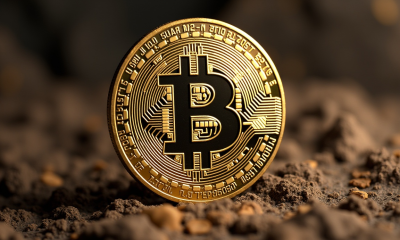

Blockchain
Bitcoin No Longer Plays Gold’s Game – Crypto News
Opinion by: Armando Aguilar, head of capital formation and growth at TeraHash
Bitcoin was treated as a purely inert asset for years: a decentralized vault, economically passive despite its fixed issuance schedule. Yet more than $7 billion worth of Bitcoin (BTC) already earns native, onchain yield via major protocols — that premise is breaking down.
Gold’s ~$23-trillion market cap mostly sits idle. Bitcoin, by contrast, now earns onchain, while holders keep custody. As new layers unlock returns, Bitcoin crosses a structural threshold: from merely passive to productively scarce.
That change is quietly redefining how capital prices risk, how institutions allocate reserves and how portfolio theory accounts for safety. Scarcity may explain price stability. Still, productivity explains why miners, treasuries and funds are now parking assets in BTC rather than just building around it.
A vault asset that earns yield isn’t digital gold anymore — it’s productive capital.
Scarcity matters, but productivity rules
Bitcoin’s economic DNA hasn’t changed: The supply remains capped at 21 million, the issuance schedule is transparent, and no central authority can inflate or censor it. Scarcity, auditability and resistance to manipulation always set Bitcoin apart, but in 2025, these differentiating and unique factors started to mean something more.
As the issuance rate is locked, even as new protocol layers allow BTC to generate onchain returns, Bitcoin is now gaining traction for what it will enable. A new set of tools gives holders the ability to earn real yield without giving up custody, relying on centralized platforms and altering the base protocol. It leaves Bitcoin’s core mechanics untouched but changes how capital engages with the asset.
We’re already seeing that effect in practice. Bitcoin is the only crypto asset officially held in sovereign reserves: El Salvador continues to allocate BTC in its national treasury, and a 2025 US executive order recognized Bitcoin as a strategic reserve asset for critical infrastructure. Meanwhile, spot exchange-traded funds (ETFs) now hold over 1.26 million BTC — more than 6% of the total supply.
Related: US Bitcoin reserve vs. gold and oil reserves: How do they compare?
Also on the mining side, public miners are no longer rushing to sell. Instead, a growing share allocates BTC into staking and synthetic yield strategies to improve long-term returns.
It’s becoming evident that the original value proposition has evolved subtly in design but profoundly in effect. What once made Bitcoin trustworthy now also makes it powerful — a once passive asset is becoming a yield-producing asset. This lays the foundation for what comes next: a native yield curve that forms around Bitcoin itself, not to mention Bitcoin‑linked assets.
Bitcoin earns without giving up control
Until recently, the idea of earning a return on crypto seemed out of reach. In Bitcoin’s case, it was hard to find non-custodial yield, at least without compromising its base-layer neutrality. But that assumption no longer holds. Today, new protocol layers let holders put BTC to work in ways once limited to centralized platforms.
Some platforms let long-term holders stake native BTC to help secure the network while earning yield, without wrapping the asset or moving it across chains. In turn, others allow users to use their Bitcoin in decentralized finance apps, earning fees from swaps and lending without giving up ownership. And the catch is that none of these systems require handing over keys to a third party, and none rely on the kind of opaque yield games that caused problems in the past.
At this point, it’s clear that this is no longer pilot-scale. In addition, miner-aligned strategies are quietly gaining traction among firms looking to boost treasury efficiency without leaving the Bitcoin ecosystem. As a result, a yield curve native to Bitcoin and grounded in transparency is starting to take shape.
Once Bitcoin yield becomes accessible and self-custodied, another problem emerges: How do you measure it? If protocols are becoming available and accessible, then clarity is missing. Because without a standard to describe what productive BTC earns, investors, treasuries and miners are left making decisions in the dark.
Time to benchmark Bitcoin yield
If Bitcoin can earn a return, then the next logical step is a straightforward way to measure it.
Right now, there’s no standard. Some investors see BTC as hedge capital; others put it to work and collect yield. However, there are inconsistencies in what the actual benchmark to measure Bitcoin should be, as there are no real comparable assets. For example, a treasury team might lock coins for a week but doesn’t have a simple way to explain the risk, or a miner might route rewards into a yield strategy but still treat it as treasury diversification.
Consider a mid-sized decentralized autonomous organization with 1,200 BTC and six months of payroll ahead. It puts half into a 30-day vault on a Bitcoin-secured protocol and earns yield. But without a baseline, the team can’t say whether that’s a cautious move or a risky one. The same choice might be praised as clever treasury work or criticized as yield-chasing, depending on who analyzes the approach.
What Bitcoin needs is a benchmark. Not a “risk‑free rate” in the bond market sense, but a baseline: repeatable, self-custodied and onchain yield that can be generated natively on Bitcoin, net of fees, grouped by term lengths — seven days, 30, 90. Just enough structure to turn yield from guesswork into something that can be referenced and used as a benchmark.
Once that exists, treasury policies, disclosures and strategies can be built around it, and everything above that baseline can be priced for what it is: risk worth taking or not.
That’s where the metaphor with gold breaks down. Gold doesn’t pay you — productive Bitcoin does. The longer treasuries treat BTC like a vault trinket with no return, the easier it is to see who’s managing capital — and who’s simply storing it.
Opinion by: Armando Aguilar, head of capital formation and growth at TeraHash.
This article is for general information purposes and is not intended to be and should not be taken as legal or investment advice. The views, thoughts, and opinions expressed here are the author’s alone and do not necessarily reflect or represent the views and opinions of Cointelegraph.
-

 others1 week ago
others1 week agoRisk-off sentiment drives selective equity positioning – BNY – Crypto News
-
others1 week ago
‘Floki Is The CEO’: FLOKI Surges Over 20% After Elon Musk’s Name Drop – Crypto News
-

 De-fi1 week ago
De-fi1 week agoCrypto Markets Recover Slightly as Fed Signals Rate Cut, End of QT – Crypto News
-
others1 week ago
Ethereum Price Targets $8K Amid John Bollinger’s ‘W’ Bottom Signal and VanEck Staked ETF Filing – Crypto News
-

 De-fi1 week ago
De-fi1 week agoCrypto Markets Recover Slightly as Fed Signals Rate Cut, End of QT – Crypto News
-

 others1 week ago
others1 week agoAUD/USD rises on US-China trade hopes, Fed rate cut outlook – Crypto News
-

 De-fi1 week ago
De-fi1 week agoCrypto Markets Recover Slightly as Fed Signals Rate Cut, End of QT – Crypto News
-

 Technology1 week ago
Technology1 week agoAWS says it has fixed the problem that crippled half the internet but many popular apps are still down – Crypto News
-
Business1 week ago
Solana Price Eyes $240 Recovery as Gemini Launches SOL-Reward Credit Card – Crypto News
-
Business1 week ago
Breaking: Michael Saylor’s Strategy Acquires 168 Bitcoin as Crypto Market Rebounds – Crypto News
-
others1 week ago
BREAKING: 21Shares Amends S-1 for Spot Dogecoin ETF Approval – Crypto News
-
others1 week ago
Analyst Predicts $10k ETH Price as Vitalik Buterin Launches Major Upgrade for Faster Proofs Systems – Crypto News
-
Business1 week ago
Bitcoin Price Prediction as Gaussian Channel Turns Green Amid U.S.–China Trade Progress and Fed Rate Cut Hopes – Crypto News
-

 Technology1 week ago
Technology1 week agoAmazon Web Services outage: Here’s how many users are impacted and the downtime costs – Crypto News
-
Technology1 week ago
Blockchain for Good Alliance and UNDP AltFinLab Launch Blockchain Impact Forum – Crypto News
-
Technology1 week ago
Blockchain for Good Alliance and UNDP AltFinLab Launch Blockchain Impact Forum – Crypto News
-

 Technology1 week ago
Technology1 week agoEthereum’s Vitalik Buterin applauds Polygon for pioneering ZK technology – Crypto News
-

 Blockchain1 week ago
Blockchain1 week agoXRP Whales Flood Binance With Massive Deposits – Selling Pressure Mounts – Crypto News
-

 Technology1 week ago
Technology1 week agoLayerZero outlook: ZRO price on the edge ahead of $43M token unlock – Crypto News
-

 Blockchain1 week ago
Blockchain1 week agoTokenized Deposits for Payments, Treasury – Crypto News
-

 Metaverse7 days ago
Metaverse7 days agoTech layoffs: From Meta, Amazon to Google — these IT majors have cut AI related jobs – Crypto News
-
Business1 week ago
How Will “Unusual” US CPI Inflation Data Release Could Impact Fed Rate Cut, Crypto Market? – Crypto News
-
Business1 week ago
Binance Founder CZ Predicts Bitcoin Will Flip Gold’s $30 Trillion Market – Crypto News
-

 De-fi1 week ago
De-fi1 week agoDeFi Earning Aggregator Turtle Raises $5.5 Million – Crypto News
-

 Blockchain1 week ago
Blockchain1 week agoBitcoin Weekly RSI Points To More Upside, But Can the Bulls Defend $107,000? – Crypto News
-

 Cryptocurrency1 week ago
Cryptocurrency1 week agoEthereum Founder Vitalik Buterin Explains GKR, Unbelievably Powerful Tech Scheme – Crypto News
-

 others1 week ago
others1 week agoFocus shifts to Canadian inflation, trade jitters and US shutdown – Crypto News
-

 Metaverse1 week ago
Metaverse1 week agoEight brilliant AI tools to supercharge productivity – Crypto News
-

 Metaverse1 week ago
Metaverse1 week agoEight brilliant AI tools to supercharge productivity – Crypto News
-

 Technology1 week ago
Technology1 week agoThinking of cancelling HBO Max? Subscription prices just went up – Here’s what you need to know – Crypto News
-
Technology1 week ago
$1.68 Trillion T. Rowe Price Files for First Active Crypto ETF Holding BTC, ETH, SOL, and XRP – Crypto News
-
Technology1 week ago
Trump Tariffs: U.S. President Threatens 155% Tariff on China, Bitcoin Falls – Crypto News
-
![Nikkei Futures (NKD) reach historic highs, extending bullish rally [Video]](https://dripp.zone/news/wp-content/uploads/2025/10/Nikkei-Futures-NKD-reach-historic-highs-extending-bullish-rally-Video-400x240.jpg)
![Nikkei Futures (NKD) reach historic highs, extending bullish rally [Video]](https://dripp.zone/news/wp-content/uploads/2025/10/Nikkei-Futures-NKD-reach-historic-highs-extending-bullish-rally-Video-80x80.jpg) others1 week ago
others1 week agoNikkei Futures (NKD) reach historic highs, extending bullish rally [Video] – Crypto News
-
others1 week ago
Analyst Predicts $10k ETH Price as Vitalik Buterin Launches Major Upgrade for Faster Proofs Systems – Crypto News
-
Technology1 week ago
Fed’s Payments Conference: Waller Floats ‘Payment Account’ Framework to Support Crypto Innovation – Crypto News
-
Technology1 week ago
ProShares Files for Index Crypto ETF Tracking Bitcoin, Ethereum, XRP, and Solana – Crypto News
-

 Technology1 week ago
Technology1 week agoChatGPT down: Thousands of users unable to access AI chatbot, OpenAI says it is working on a fix – Crypto News
-
Business1 week ago
XRP Price Classical Pattern Points to a Rebound as XRPR ETF Hits $100M Milestone – Crypto News
-

 Metaverse7 days ago
Metaverse7 days agoBezos fund believes AI can save the planet. Nvidia, Google are all-in. – Crypto News
-

 Cryptocurrency7 days ago
Cryptocurrency7 days agoCrypto update: Bitcoin and Ethereum are stable as market’s focus shifts to US inflation data – Crypto News
-

 Blockchain1 week ago
Blockchain1 week agoCardano Could Be 2026 Game-Changer – Crypto News
-
others1 week ago
Analyst Predicts $10k ETH Price as Vitalik Buterin Launches Major Upgrade for Faster Proofs Systems – Crypto News
-

 De-fi1 week ago
De-fi1 week agoHumidiFi Tops Monthly Solana DEX Volumes and Teases Airdrop – Crypto News
-

 others1 week ago
others1 week agoAustralian Dollar remains subdued as US Dollar corrects upwards – Crypto News
-

 Cryptocurrency1 week ago
Cryptocurrency1 week agoExclusive: YZi Labs leads $25M round for Sign – Crypto News
-

 Technology1 week ago
Technology1 week agoOnePlus 15R full specifications leaked ahead of launch: here’s what to expect – Crypto News
-

 Cryptocurrency1 week ago
Cryptocurrency1 week agoStreamer Sam Pepper Banned From Pump.fun, Kick After Injuring Girl With Firework Stunt – Crypto News
-
Business1 week ago
Chainlink Price Eyes $27 Rebound as Whales Accumulate 54M LINK – Crypto News
-
Business1 week ago
Crypto Czar David Sacks to Meet Senate Republicans In Bid To Advance Market Structure Bill – Crypto News
-
others1 week ago
Veteran Trader Peter Brandt Says “MSTR Could Go Underwater” If Bitcoin Repeats 1977 Soybean Crash – Crypto News


















